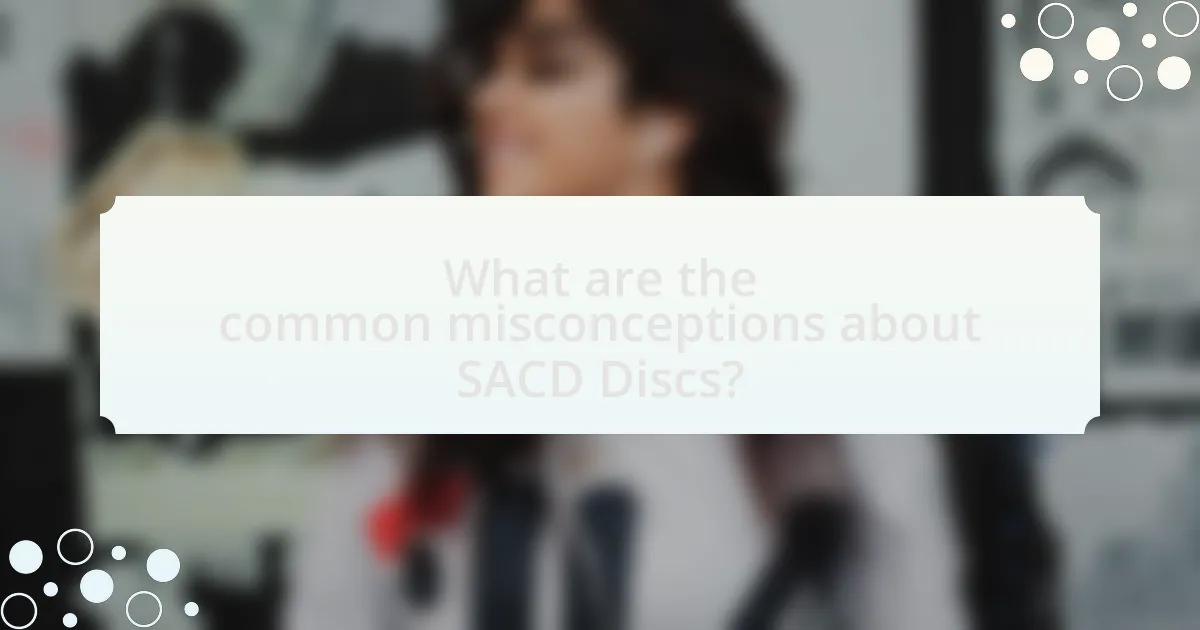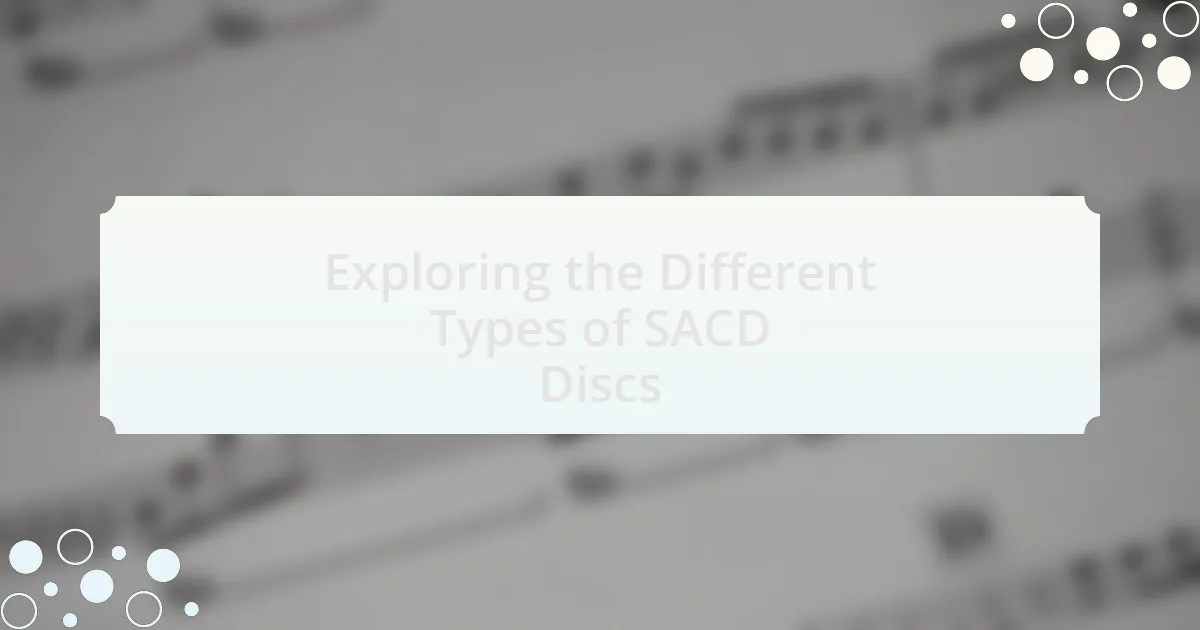SACD discs, or Super Audio Compact Discs, are high-resolution audio formats that provide superior sound quality compared to standard CDs, utilizing Direct Stream Digital (DSD) encoding. This article explores the various types of SACD discs, including hybrid, single-layer, and multi-channel formats, highlighting their differences in audio quality, storage capacity, and playback compatibility. Additionally, it addresses common misconceptions about SACDs, their relevance in the modern audio landscape, and best practices for handling and optimizing the listening experience. The discussion emphasizes the technical specifications that set SACDs apart and the advantages they offer to audiophiles and music enthusiasts.
What are SACD Discs?

SACD discs, or Super Audio Compact Discs, are high-resolution audio formats designed to provide superior sound quality compared to standard CDs. Introduced in 1999 by Sony and Philips, SACD discs utilize a different encoding method called Direct Stream Digital (DSD), which captures audio at a higher sampling rate than traditional PCM used in CDs. This technology allows for a more accurate reproduction of sound, making SACD discs popular among audiophiles.
How do SACD Discs differ from standard CDs?
SACD discs differ from standard CDs primarily in their audio quality and storage capacity. SACD, or Super Audio CD, utilizes a different encoding format called Direct Stream Digital (DSD), which allows for higher resolution audio compared to the Pulse Code Modulation (PCM) used in standard CDs. While a standard CD typically holds about 700 MB of data and supports 16-bit/44.1 kHz audio, an SACD can store up to 8.5 GB of data and supports 1-bit/2.8224 MHz audio, resulting in a more detailed and dynamic sound experience. This difference in technology and capacity is what sets SACDs apart from standard CDs.
What technical specifications set SACD Discs apart?
SACD discs are distinguished by their use of Direct Stream Digital (DSD) encoding, which allows for higher audio resolution compared to standard CDs. This encoding method operates at a sampling rate of 2.8224 MHz, significantly surpassing the 44.1 kHz of traditional CDs, resulting in a more detailed and nuanced sound reproduction. Additionally, SACDs can store both stereo and multi-channel audio formats, accommodating up to six channels, which enhances the listening experience. The physical structure of SACD discs also includes a hybrid layer, enabling compatibility with standard CD players while providing the enhanced audio quality when played on SACD-compatible devices.
Why are SACD Discs considered high-resolution audio formats?
SACD discs are considered high-resolution audio formats because they utilize Direct Stream Digital (DSD) encoding, which offers a sampling rate of 2.8224 MHz, significantly higher than the standard CD’s 44.1 kHz. This higher sampling rate allows for greater detail and accuracy in sound reproduction, resulting in a more immersive listening experience. Additionally, SACDs can store multi-channel audio, further enhancing the audio quality and depth compared to traditional formats.
What are the main types of SACD Discs available?
The main types of SACD discs available are hybrid SACDs, single-layer SACDs, and multi-channel SACDs. Hybrid SACDs contain both a standard CD layer and a high-resolution SACD layer, allowing compatibility with regular CD players and SACD players. Single-layer SACDs consist solely of the high-resolution SACD layer, requiring an SACD player for playback. Multi-channel SACDs offer surround sound capabilities, providing an immersive audio experience by utilizing multiple audio channels. These distinctions are essential for understanding the various formats and their playback requirements.
What distinguishes hybrid SACDs from single-layer SACDs?
Hybrid SACDs are distinguished from single-layer SACDs by their dual-layer structure, which allows them to contain both high-resolution Super Audio CD (SACD) audio and standard CD audio on the same disc. This design enables hybrid SACDs to be played on both SACD players and standard CD players, providing greater compatibility and accessibility for users. In contrast, single-layer SACDs only contain the high-resolution audio layer, making them playable exclusively on SACD-compatible devices. This difference in structure and compatibility is a key factor in the functionality and usability of the two types of discs.
How do multi-channel SACDs enhance the listening experience?
Multi-channel SACDs enhance the listening experience by providing a more immersive sound environment through the use of multiple audio channels. This format allows for sound to be distributed across various speakers, creating a three-dimensional audio landscape that traditional stereo formats cannot achieve. Research indicates that listeners often perceive greater depth and clarity in music when experienced in multi-channel formats, as it replicates the way sound is naturally heard in real life. For instance, a study by the Audio Engineering Society highlights that multi-channel audio can significantly improve spatial perception and listener engagement, making the overall experience more enjoyable and lifelike.
What are the advantages of using SACD Discs?
SACD discs offer superior audio quality compared to standard CDs due to their ability to store high-resolution audio formats. This high-resolution capability allows for a wider dynamic range and greater detail in sound reproduction, making them ideal for audiophiles. Additionally, SACDs can contain both stereo and multi-channel audio tracks, providing a more immersive listening experience. The DSD (Direct Stream Digital) encoding used in SACDs minimizes distortion and preserves the nuances of the original recording, further enhancing sound fidelity.
How does SACD technology improve sound quality?
SACD technology improves sound quality by utilizing a higher sampling rate and bit depth compared to standard CDs, allowing for more accurate audio reproduction. Specifically, SACD employs Direct Stream Digital (DSD) encoding, which captures audio at a 2.8 MHz sampling rate, significantly surpassing the 44.1 kHz of CDs. This increased resolution results in a more detailed and dynamic sound, enhancing the listening experience. Additionally, SACD supports multi-channel audio, providing a more immersive soundstage that traditional stereo formats cannot achieve.
What are the benefits of multi-channel audio in SACD Discs?
Multi-channel audio in SACD discs enhances the listening experience by providing a more immersive sound environment. This format allows for sound to be distributed across multiple channels, creating a three-dimensional audio experience that closely resembles a live performance. The use of additional channels enables greater detail and clarity in sound reproduction, allowing listeners to perceive subtle nuances in music that may be lost in stereo formats. Furthermore, multi-channel audio supports advanced mixing techniques, which can enhance the emotional impact of music by placing instruments and vocals in specific spatial locations. This capability is backed by the technical specifications of SACD, which supports up to six channels of audio, offering a significant upgrade over traditional stereo recordings.
How can one choose the right type of SACD Disc?
To choose the right type of SACD disc, one should consider the audio format compatibility, the specific music genre, and the quality of the recording. SACD discs come in two main formats: hybrid and single-layer. Hybrid discs contain both a standard CD layer and a high-resolution SACD layer, making them versatile for different playback systems. Single-layer discs offer superior sound quality but require a dedicated SACD player. Additionally, selecting discs that feature music in genres known for high-quality recordings, such as classical or jazz, can enhance the listening experience. The choice should also reflect personal audio preferences and the capabilities of the playback equipment.
What factors should be considered when selecting an SACD Disc?
When selecting an SACD disc, factors such as audio quality, genre, and compatibility with playback equipment should be considered. Audio quality is paramount, as SACDs are designed to provide superior sound through high-resolution audio formats. The genre is important because SACDs are available across various music styles, and personal preference will guide the selection. Compatibility with playback equipment is crucial, as not all CD players can read SACD discs; therefore, ensuring that the player supports SACD playback is essential for optimal listening experience.
How does the choice of SACD Disc impact the overall listening experience?
The choice of SACD disc significantly impacts the overall listening experience by determining the audio quality and format available to the listener. SACD discs can be single-layer, dual-layer, or hybrid, with each type offering different levels of sound fidelity. For instance, a single-layer SACD provides high-resolution audio, while a hybrid disc allows for compatibility with standard CD players, thus broadening accessibility. The audio quality is further enhanced by the DSD (Direct Stream Digital) encoding used in SACDs, which captures sound with greater detail compared to traditional formats. Studies have shown that listeners often perceive SACD’s sound quality as superior, particularly in terms of clarity and depth, which can lead to a more immersive listening experience.
What are the common misconceptions about SACD Discs?

Common misconceptions about SACD discs include the belief that they are only compatible with high-end audio systems and that they provide a significant improvement in sound quality over standard CDs. In reality, SACD discs can be played on a variety of players, including many standard CD players that support SACD playback, and while they do offer higher resolution audio, the perceived improvement in sound quality can vary based on the listener’s equipment and the specific recording. Additionally, some people think that SACD is exclusively a format for classical music, but it encompasses a wide range of genres, including rock, jazz, and pop, as many artists have released albums in this format.
Why do some people believe SACD Discs are obsolete?
Some people believe SACD discs are obsolete due to the rise of digital streaming services and high-resolution audio formats that offer similar or superior sound quality without the need for physical media. The convenience and accessibility of platforms like Tidal and Qobuz, which provide high-resolution audio, have diminished the demand for SACD discs. Additionally, the limited availability of SACD players and the niche market for these discs contribute to the perception of their obsolescence, as fewer consumers are willing to invest in specialized equipment for a format that is not widely supported.
What evidence supports the continued relevance of SACD Discs?
SACD discs remain relevant due to their superior audio quality and niche market demand. The format supports high-resolution audio, offering a dynamic range and clarity that surpasses standard CDs, which appeals to audiophiles and collectors. Additionally, sales data indicates a steady interest in SACD releases, particularly in genres like classical and jazz, where sound fidelity is paramount. For instance, the continued production of new SACD titles by major labels, alongside the presence of dedicated SACD players in the market, further underscores the format’s enduring appeal.
How do SACD Discs fit into the modern audio landscape?
SACD discs fit into the modern audio landscape as a high-resolution audio format that offers superior sound quality compared to standard CDs. Introduced in 1999, SACD utilizes Direct Stream Digital (DSD) technology, which allows for a greater dynamic range and more accurate sound reproduction. This format appeals to audiophiles and music enthusiasts who prioritize audio fidelity, as it supports multi-channel audio and higher sampling rates. Despite the rise of digital streaming services, SACD remains relevant due to its physical media appeal and the continued release of new titles, particularly in genres like classical and jazz, where sound quality is paramount.
What role do SACD Discs play in high-fidelity audio systems?
SACD discs serve a crucial role in high-fidelity audio systems by providing superior sound quality through their ability to store and reproduce audio in both stereo and multi-channel formats. This format utilizes Direct Stream Digital (DSD) encoding, which captures audio at a higher resolution than standard CDs, resulting in a more accurate and detailed sound reproduction. The SACD format supports sampling rates of up to 2.8224 MHz, significantly exceeding the 44.1 kHz of traditional CDs, thus allowing for a more nuanced listening experience.
How are SACD Discs being marketed to new audiences?
SACD discs are being marketed to new audiences through targeted digital campaigns and collaborations with streaming services. These marketing strategies emphasize the superior audio quality and immersive listening experience that SACD offers compared to standard formats. For instance, partnerships with high-end audio brands and promotional events at music festivals showcase SACD’s capabilities, attracting audiophiles and casual listeners alike. Additionally, social media platforms are utilized to reach younger demographics, highlighting the unique features of SACD, such as multi-channel sound and high-resolution audio, which appeal to modern consumers seeking enhanced music experiences.
What are the best practices for using SACD Discs?

The best practices for using SACD discs include ensuring compatibility with SACD players, handling discs carefully to avoid scratches, and storing them in a cool, dry place to prevent damage. SACD discs require specific players that can read both the standard CD layer and the high-resolution SACD layer, which is crucial for optimal playback quality. Proper handling involves holding the edges of the disc and avoiding contact with the surface to maintain sound quality. Additionally, storing SACDs in protective cases away from direct sunlight and humidity helps preserve their integrity, as environmental factors can degrade the disc over time.
How should SACD Discs be stored and handled?
SACD discs should be stored vertically in a cool, dry place away from direct sunlight to prevent warping and damage. Proper handling involves holding the disc by the edges to avoid fingerprints and scratches on the surface. Additionally, using protective cases can further safeguard the discs from dust and physical impact. These practices are essential because SACD discs are sensitive to environmental factors and physical contact, which can affect their playback quality.
What precautions should be taken to maintain SACD Disc quality?
To maintain SACD disc quality, it is essential to handle the discs carefully and store them properly. Handling should involve holding the edges to avoid fingerprints and scratches on the surface, as these can affect playback quality. Proper storage requires keeping SACD discs in their original cases or protective sleeves, away from direct sunlight and extreme temperatures, which can warp or damage the discs. Additionally, cleaning the discs with a soft, lint-free cloth in a radial motion can help remove dust and smudges without scratching the surface. These precautions are supported by industry standards that emphasize the importance of proper handling and storage to prolong the lifespan and performance of optical media.
What tips can enhance the SACD listening experience?
To enhance the SACD listening experience, ensure high-quality playback equipment is used, including a dedicated SACD player and high-fidelity speakers. High-quality equipment is essential because SACDs are designed to deliver superior sound quality through their high-resolution audio formats. Additionally, optimize the listening environment by minimizing background noise and ensuring proper speaker placement, as these factors significantly affect sound clarity and immersion. Research indicates that acoustic treatment in listening spaces can further improve audio performance, making the listening experience more enjoyable.
How can one optimize their audio setup for SACD playback?
To optimize an audio setup for SACD playback, one should use a dedicated SACD player that supports both stereo and multi-channel formats. This ensures the highest fidelity and utilizes the full capabilities of SACD, which offers higher resolution audio compared to standard CDs. Additionally, connecting the SACD player via HDMI or a high-quality analog connection to a compatible receiver or amplifier enhances sound quality. The use of high-quality speakers that can accurately reproduce the extended frequency range of SACD is also essential. Proper speaker placement and room acoustics further improve the listening experience by minimizing reflections and optimizing soundstage.
What are common troubleshooting steps for SACD playback issues?
Common troubleshooting steps for SACD playback issues include checking the compatibility of the SACD player with the disc format, ensuring the disc is clean and free from scratches, and verifying that the correct audio output settings are selected on the player. Additionally, users should confirm that the player is properly connected to the audio system and that the audio system supports SACD playback. If problems persist, updating the player’s firmware or consulting the user manual for specific error codes may provide further guidance.

Leave a Reply